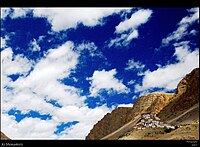Kye monastery
Key Gompa (also: Ki , Kye or Kee ) is a Tibetan Buddhist monastery in India , which is located on a mountain at 4,166 meters above sea level , near the Spiti River in the Spiti Valley in the Lahaul and Spiti District of India State of Himachal Pradesh is located. Key Gompa is now part of the Gelug School together with the Tabo Monastery and the Drangtse Monastery .
It is the largest monastery in the Spiti Valley and a religious education center for llamas . In 1855 100 monks lived here . In the architectural allocation of the various monasteries, Kye falls under the Pasada style , which is characterized by more than one floor and often plays a role in fortress monasteries .
history
Key Gompa is said to have been founded by Drom Tönpa (1004 / 1005-1064 AD), who was a pupil of the important teacher Atisha in the 11th century . This statement could also refer to the former Kadam monastery in the nearby village of Rangrik , which was probably destroyed in the 14th century when the Sakya school achieved its rise to power with Mongol support.
The Kye Monastery was attacked again by the Mongols during the reign of the 5th Dalai Lama ( Ngawang Lobsang Gyatsho ) in the 17th century and became an institution of the Gelug School of Tibetan Buddhism . In 1820 it was sacked during the wars between Ladakh and Kullu . In 1841 it was badly damaged by the Dogra Army under Ghulam Kahn and Rahim Kahn. Later that year it suffered even more damage from a Sikh army. It was devastated by a fire in the 1840s and a major earthquake caused damage in 1975 which was repaired with the help of the Archaeological Survey of India and the State Public Works Department.
The successive destruction and the subsequent multiple reconstruction resulted in disorderly growth with box-shaped extensions and buildings, so that the monastery now looks like a fortress - with temples that were built on top of one another. However, Key Gompa is still an outstanding example of 14th century monastery architecture that developed under Chinese influence. The Kye Monastery has a collection of very old wall paintings and books of great aesthetic value, as well as pictures and statuettes of Buddha practicing Dhyana ( meditation ).
The main building has three floors. The first floor is mostly underground and serves as a warehouse. A room called Tangyur is richly decorated with wall paintings. The ground floor has a beautifully decorated meeting hall and cells for many monks.
- “The Kee Monastery, for example, houses almost 250 monks who stay within the holy walls in winter and are with their parents or brothers in summer, work in the fields or act as porters for travelers. These monasteries have their ordinary heads, rulers or abbots and the higher sacred titles can only be attained by aspirants if they personally go to either Shigatzee ( Xigazê ) or Lhassa ( Lhasa ). ” “ (The monastery of Kee, for instance, accommodates nearly 250 monks, who reside within the sacred walls in winter, and stay during the summer with their parents or brothers, working in the fields, or employed in carrying travelers' goods. These monasteries have their regular heads, or abbots, and the higher ecclesiastical titles can only be obtained by the candidates proceeding in person to either Shigatzee (Shigatse) or Lhassa (Lhasa).) "
The millennium was celebrated in 2000 in the presence of the Dalai Lama ( Tendzin Gyatsho ).
Individual evidence
- ↑ Sarina Singh et al. (2007): India . 12th edition, Lonely Planet, ISBN 978-1741043082 , p. 343
- ↑ Handa, OC (1987): Buddhist Monasteries in Himachal Pradesh . Indus Publishing Company, New Delhi. ISBN 81-85182-03-5 , p. 131
- ↑ HimachalWorld.com - Monasteries in Himachal Pradesh (English)
- ↑ Francke, AH (1914): Antiquities of Indian Tibet , 2 volumes, Calcutta, 1972 new edition: S. Chand, New Delhi, pp. 45–47
- ↑ Handa, OC (1987): Buddhist Monasteries in Himachal Pradesh . Indus Publishing Company, New Delhi. ISBN 81-85182-03-5 , pp. 97 and 99
- ↑ a b Handa, OC (1987): Buddhist Monasteries in Himachal Pradesh . Indus Publishing Company, New Delhi. ISBN 81-85182-03-5 , pp. 100-101
- ↑ a b SurfIndia.com - Kye Monastery (English) ( Memento of the original from August 4, 2009 in the Internet Archive ) Info: The archive link was automatically inserted and not yet checked. Please check the original and archive link according to the instructions and then remove this notice.
- ↑ Harcourt, AFP (1871): On the Himalayan Valleys: - Kooloo, Lahoul, and Spiti. Proceedings of the Royal Geographical Society of London, p. 256
literature
- Handa, OC (1987): Buddhist Monasteries in Himachal Pradesh . Indus Publishing Company, New Delhi. ISBN 81-85182-03-5
- Harcourt, AFP (1871): On the Himalayan Valleys: - Kooloo, Lahoul, and Spiti. Proceedings of the Royal Geographical Society of London, Vol. 15, No. 5, pp. 336-343
- Kapadia, Harish (1999): Spiti: Adventures in the Trans-Himalaya . 2nd edition, Indus Publishing Company, New Delhi. ISBN 81-7387-093-4
- Janet Rizvi (1996): Ladakh: Crossroads of High Asia . 2nd edition, Oxford University Press, Delhi. ISBN 019564546-4
- Cunningham, Alexander (1854). LADĀK: Physical, Statistical, and Historical with Notices of the Surrounding Countries . London, reprint: Sagar Publications (1977)
- Francke, AH (1914): Antiquities of Indian Tibet , 2 volumes, Calcutta, 1972 New edition: S. Chand, New Delhi
- Francke, AH (1977): A History of Ladakh (originally published as A History of Western Tibet (1907)). 1977 edition with a critical introduction and commentary by SS Gergan and FM Hassnain. Sterling Publishers, New Delhi
- Sarina Singh et al. (2007): India . 12th edition, Lonely Planet, ISBN 978-1741043082
Web links
- HimachalWorld.com - Monasteries in Himachal Pradesh (English)
- SurfIndia.com - Kye Monastery (English)
Coordinates: 32 ° 17 ′ 51 ″ N , 78 ° 0 ′ 43 ″ E





